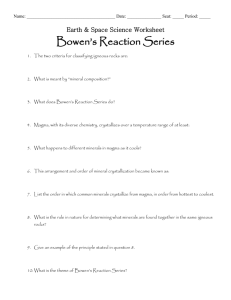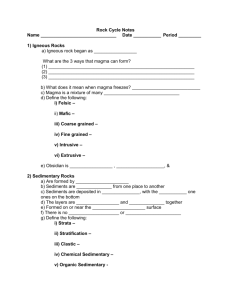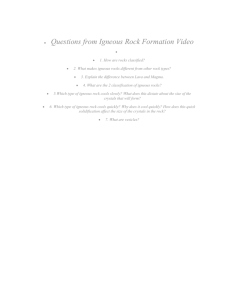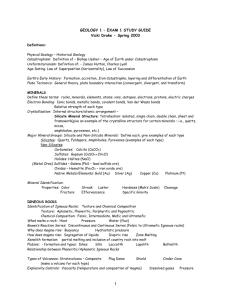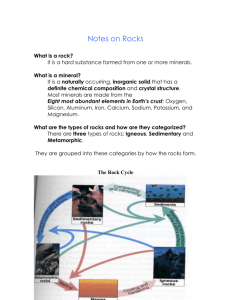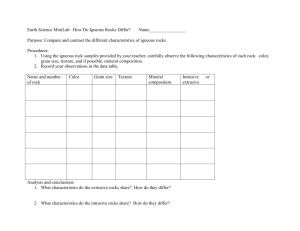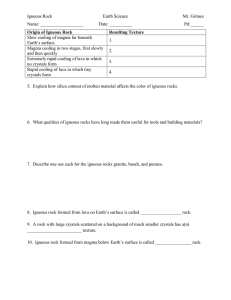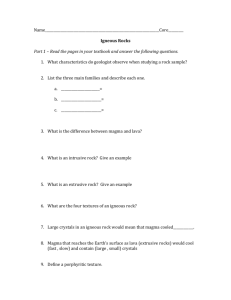igneous rocks - Science with Ms. Reathaford!
advertisement
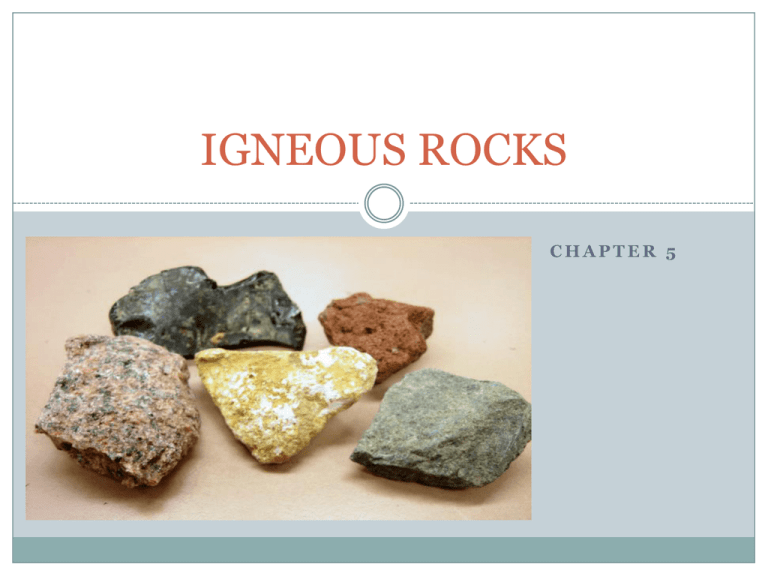
IGNEOUS ROCKS CHAPTER 5 What are Igneous Rocks? •I G N E O U S R O C K S F O R M F R O M T H E C R Y S T A L L I Z A T I O N O F MAGMA •I G N E O U S I S L A T I N F O R “ F I R E ” •M O S T I G N E O U S R O C K S A R E A S S O C I A T E D W I T H F I E R Y L A V A FLOWS •( L A V A I S S I M P L Y M A G M A T H A T F L O W S O N T O T H E S U R F A C E O F THE EARTH). Types of Igneous Rocks Extrusive Fine-grained igneous rocks that cool quickly on the Earth’s surface Rhyolite forms quickly on the Earth’s surface, which makes it a common extrusive igneous rock Intrusive Course-grained igneous rocks that cool slowly beneath the Earth’s surface Granite is the most common intrusive igneous rock Composition of Magma Magma is a mixture of molten rock, gases, and mineral crystals The major elements that make up the different minerals in the Earth’s crust are the same major elements that make up magma Three types of magma, categorized based on the amount of silica (SiO2) Basaltic • Dark and fluid • Flows slowly • Not explosive Andesitic • Thick Rhyolitic and chunky • Highly explosive • Intermediate flow • High levels of SiO2 • Intermediate explosions Magma is formed from the heat and pressure from inside the Earth. Factors that affect magma formation are: 1. Temperature 2. Pressure 3. Water Content 4. Mineral Composition Origins of Magma How Rocks Melt Rocks melt in different ways, based on their composition This explains why magma is a mixture of crystals and molten rock Partial Melting The process where some minerals melt at low temperatures while others remain solid As each group of minerals melts, different elements are added to the magma, changing the composition If temperatures are not great enough, only part of the rock will melt The resulting magma will therefore have a different chemistry from the original rock Fractional Crystallization The process where different minerals crystallize at different rates The process is similar to partial melting; however, during fractional crystallization the changes have occurred due to crystallization When fractional crystallization occurs, elements are removed from the remaining magma (rather than being added like partial melting) Classifying Igneous Rocks IGNEOUS ROCKS ARE CLASSIFIED ACCORDING TO: 1. Mineral compositions 2. Grain size 3. Texture THREE MAIN GROUPS 1. Felsic (light colored, high silica) 2. Mafic (Dark Colored, low silica) 3. Intermediate (Moderate amounts of each) Grain Size Varies depending on the amount of time lava/magma takes to cool Outside of Earth, lava cools quickly and produces little to no visible crystals (Obsidian, Andesite, Basalt) Inside of Earth, magma cools slowly and produces large , coarse, crystals (Gabbro, Granite, Diorite) Texture As grains crystallize from magma, they grow together and form irregular edges. Although this is characteristic of many igneous rocks, wellshaped crystals can also form under certain conditions. Many rocks have porphyritic texture, which is characterized by large, well-formed crystals surrounded by finer-grained crystals of the same or different material. To show porphyritic texture, we know that a complex cooling history took place wherein a slowly cooling magma suddenly shifted to a rapid cooling magma. Chances are, the crystals grew so large that they intruded into the Earth’s crust! Igneous Rocks as Resources Usefulness in building materials: Strength due to interlocking grain textures Many minerals in igneous rocks are resistant to weathering Beauty of crystals are desired in modern decorating (granite) Ore deposits (found through igneous intrusions) Veins – found in layered intrusions of surrounding rocks Pegmatities – Veins of extremely large-grained minerals Kimberlites – Diamonds are found in intrusions of these rocks
